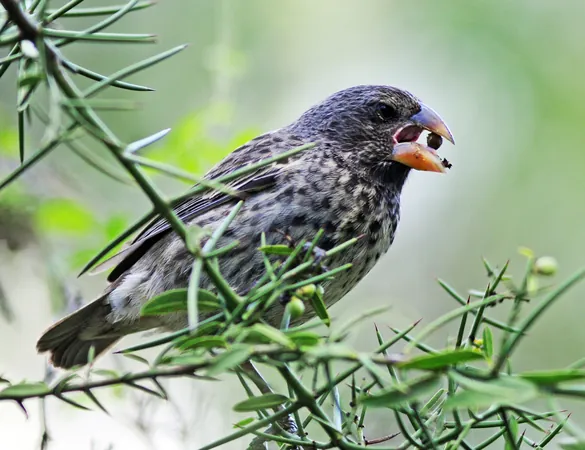
Music for Evolution: How Songs of Future Finches Could Spark New Species on the Galapagos Islands!
2024-10-10
Author: Sophie
Introduction
In a groundbreaking study published in *Science*, researchers from the University of Massachusetts Amherst have unveiled a critical link between environmental change and the emergence of new species, specifically through the iconic Darwin's finches of the Galapagos Islands. Although the theory of ecological speciation has long been postulated, proving it experimentally has remained a significant challenge—until now.
Darwin's Finches and Their Adaptive Beaks
Darwin's finches are renowned for their adaptive beak shapes, which respond to varying ecological conditions. Previous studies had established that these beak changes influence the birds' singing patterns, yet the precise mechanism that drives the emergence of new finch species remained elusive.
The Podos Study
The recent study led by Professor Jeffrey Podos provides the empirical evidence needed to bridge this gap by demonstrating that altered songs—shaped by changes in beak morphology—can affect species recognition, potentially leading to speciation.
Historical Context
Podos reflects on his long-standing research on these fascinating birds, stating, "In my very first publication on the finches, I speculated about the connection between song changes and beak evolution, but lacked the definitive experimental proof to back it up." This study sought to close that gap by designing an experiment based on extensive prior research that tracked morphological changes in finch beaks due to environmental pressures.
Impact of Environmental Changes
To explore this relationship, the researchers focused on the impact of droughts, which tend to favor finches with thicker beaks. These thicker beaks not only enhance seed-crushing abilities but also limit the finches' capacity for complex songs. Indeed, Podos emphasized, "A powerful beak is just too clunky for the intricate movements required for advanced singing."
Predictive Modeling of Future Finch Songs
Using predictive modeling, the team was able to simulate how future environmental conditions—specifically repeated drought events—would alter the beak shapes and singing capabilities of the finches. They engineered the calls of "future finches" by mimicking the expected changes in song frequency and complexity resulting from environmental shifts.
Experimental Approach and Findings
After creating these simulated calls, Podos and his team played them to a population of Darwin's medium ground finches. Astonishingly, while there was little response to calls simulating three drought events, by the time they reached six drought events, the finches hardly reacted at all. This suggests that environmental changes coupled with evolving song characteristics could lead to significant species divergence over time.
Implications of the Study
These findings not only support the idea of ecological speciation but also raise important questions about the future of Darwin's finches in the era of climate change. Will heightened drought conditions catalyze the emergence of new finch species, or will they threaten the survival of existing ones?
Conclusion
As researchers continue to explore these connections, the implications of this study are vast, potentially offering crucial insights into how species adapt—or fail to adapt—under intense environmental stress. This intriguing research showcases the intricate dance of evolution, highlighting how changes in the environment can lead to striking transformations within species. The echoes of future finches may resonate not just through the air of the Galapagos Islands but also in our understanding of the processes that shape biodiversity on our planet. What other secrets of evolution lie just beyond our current understanding? The quest for answers continues!









 Brasil (PT)
Brasil (PT)
 Canada (EN)
Canada (EN)
 Chile (ES)
Chile (ES)
 España (ES)
España (ES)
 France (FR)
France (FR)
 Hong Kong (EN)
Hong Kong (EN)
 Italia (IT)
Italia (IT)
 日本 (JA)
日本 (JA)
 Magyarország (HU)
Magyarország (HU)
 Norge (NO)
Norge (NO)
 Polska (PL)
Polska (PL)
 Schweiz (DE)
Schweiz (DE)
 Singapore (EN)
Singapore (EN)
 Sverige (SV)
Sverige (SV)
 Suomi (FI)
Suomi (FI)
 Türkiye (TR)
Türkiye (TR)